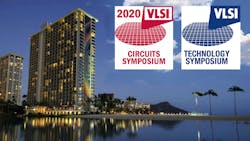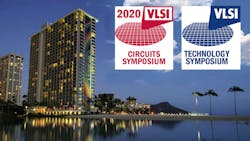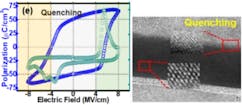IEEE's Two-fer Deal: Two Virtual Symposia on VLSI Technology & Circuits for One Fee
Although the pandemic has put many aspects of our lives on hold, we'll still be able to attend the IEEE's double-feature Symposia on VLSI Technology & Circuits in Cyberspace from June 15-18, 2020. To celebrate its 40th anniversary, the event is organized around the theme “The Next 40 Years of VLSI for Ubiquitous Intelligence,” and will be held on a fully overlapping schedule online. A single registration fee includes both events.
The two Symposia have been held together since 1987, providing an opportunity for the world’s top device technologists and circuit and system designers to exchange leading-edge research on microelectronics technology, with alternating venues between Hawaii and Japan. Presented for the first (and hopefully last) time as a completely virtual conference, the Symposia provide a unique forum for conversations between device technologists and circuit/systems designers in the emerging fields of machine learning, IoT, AI, wearable/implantable biomedical applications, big data, cloud/edge computing, robotics, and autonomous vehicles. The virtual conference program will include technical presentations, plenary sessions, panel discussions, joint focus sessions, and Short Courses presented in an online format.
The virtual Symposium on VLSI Technology & Circuits will hold Short Courses on June 15 and a forum session dedicated to edge intelligence topics on June 17. A single registration enables participants to attend both Symposia.
The Symposia program provides a unique perspective on the microelectronics industry by integrating the technology ecosystem of converging industry trends. The advanced circuit design and application platforms will realize the future promise of “ubiquitous intelligence.”
The weeklong virtual conference will feature technical presentations, plenary sessions, panel discussions, joint focus sessions, and the aforementioned Short Courses presented in an online format. Additional information and registration can be accessed here: http://www.vlsisymposium.org.
The entire program can be viewed at https://vlsisymposium.org/program/, but some of the highlights are posted below.
Program Highlights
Plenary Sessions (June 15 and 17)
The first plenary session on June 15 will include “5G Evolution and 6G” by Takehiro Nakamura, Sr. VP & GM, 5G Laboratories, NTT DOCOMO, and “Silicon is Greener: Why Innovation in Circuits is Needed for Sustainability,” by Jen Lloyd, VP, Precision Technology & Platforms Group, Analog Devices.
The second plenary session on June 17 will include “The Future of Compute: How the Data Transformation is Reshaping VLSI,” by Michael C. Mayberry, CTO, Intel Corp., and “Empowering Next-Generation Applications through FLASH Innovation” by Shigeo (Jeff) Ohshima, technology executive at KIOXIA (formerly Toshiba Memory).
Joint Focus Sessions
The event's interdisciplinary program elements include a series of joint focus sessions to present contributed papers from the Technology and Circuits programs. Topics will include: “Silicon Photonics,” “5G / mm-wave,” “System-Technology Co-Optimization (STCO) / Design-Technology Co-Optimization (DTCO),” and “MRAM Future – Opportunities Beyond Spin-Torque Transfer (STT).”
Panel Sessions (June 16 & 18)
The Technology panel discussion on June 16, moderated by Gary Bronner, Rambus, addresses the question: “Memory & Logic Technology Divergence: Will AI/ML Bring Them Back Together?
The topic of the evening Circuits panel session, held on June 18, is “Human vs. Machine: The Future Role of AI/Machine Learning in Circuit Design.”
Short Courses (June 15)
Technology
- “Future of Scaling for Logic & Memory” will cover a range of topics, including nanosheet transistors, on-die interconnect challenges, a review of previous memory scaling challenges, ferroelectric hafnium-oxide applications in memory, and the use of EUV lithography.
- “More than Moore” will address emerging technologies for TSV-free monolithic 3D ICs, in-situ BELO transistors and oxides, and layer transfer technologies for heterogeneous integration.
Circuits
- “Trends & Advancement in Circuit Design” will address a variety of topics, including topologies of switched capacitor converters, noise-shaping SAR ADC techniques, next-generation resistor-based sensors, time reference and frequency generation, ultra-miniaturized wireless transceiver IC design, high-speed serial links for high-density I/O applications, and design considerations for emerging memories and in-memory computing.
- “Heterogeneous Integration – To Boldly Go Where No Moore Has Gone Before,” is a Joint Technology/Circuits Short Course that will cover a range of topics, including chiplet design benefits and limitations, heterogeneous system partitioning, back-end (OSAT) 2.5D/3D solutions, heterogeneous integration for AI, 3D packaging for MEMS and sensors, I/O circuits, tools and flows, and design strategies for memories.
“Friday” Forum (June 17)
The Symposia program will include a virtual forum session (formerly known as the Friday Forum)—a series of presentations focusing on “Technologies & Circuits for Edge Intelligence.” It’s led by experts in the field who will help guide participants in discussions on the contributions of technology and circuits needed to drive the future of advanced edge computing.
Workshops (June 16 and 17)
Held before the main Symposia technical sessions begin, these workshops provide additional learning opportunities for participants. Workshop topics include:
- “Know Where You Are Going: Metrology in the New Age of Semiconductor Manufacturing”
- “Analog Computing Technologies & Circuits for Efficient Machine Learning Hardware”
- “Quantum Computing: Maximizing the Impact of the Semiconductor Industry”
Additional information and registration can be accessed here: http://www.vlsisymposium.org.
About the Author
Lee Goldberg
Contributing Editor
Lee Goldberg is a self-identified “Recovering Engineer,” Maker/Hacker, Green-Tech Maven, Aviator, Gadfly, and Geek Dad. He spent the first 18 years of his career helping design microprocessors, embedded systems, renewable energy applications, and the occasional interplanetary spacecraft. After trading his ‘scope and soldering iron for a keyboard and a second career as a tech journalist, he’s spent the next two decades at several print and online engineering publications.
Lee’s current focus is power electronics, especially the technologies involved with energy efficiency, energy management, and renewable energy. This dovetails with his coverage of sustainable technologies and various environmental and social issues within the engineering community that he began in 1996. Lee also covers 3D printers, open-source hardware, and other Maker/Hacker technologies.
Lee holds a BSEE in Electrical Engineering from Thomas Edison College, and participated in a colloquium on technology, society, and the environment at Goddard College’s Institute for Social Ecology. His book, “Green Electronics/Green Bottom Line - A Commonsense Guide To Environmentally Responsible Engineering and Management,” was published by Newnes Press.
Lee, his wife Catherine, and his daughter Anwyn currently reside in the outskirts of Princeton N.J., where they masquerade as a typical suburban family.



